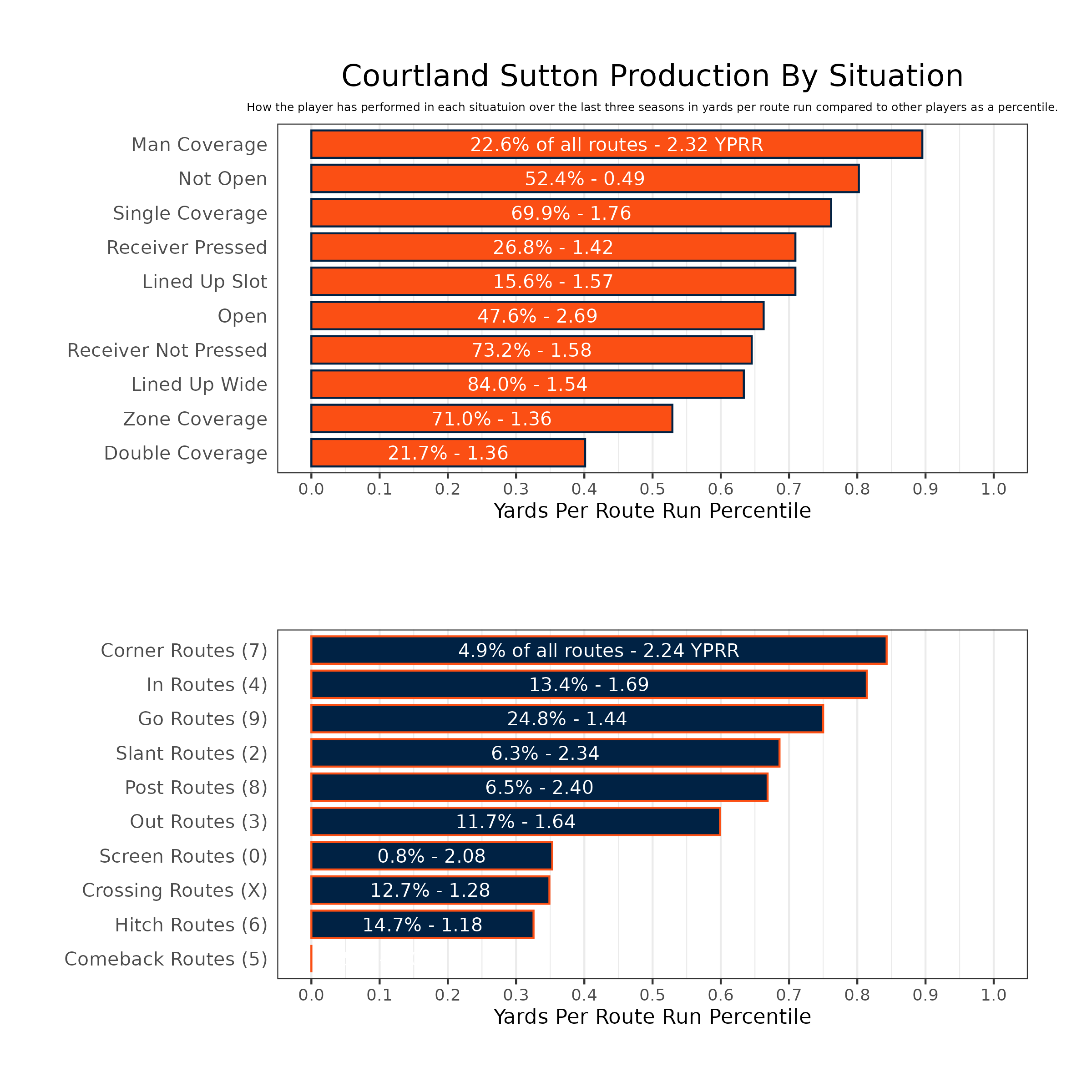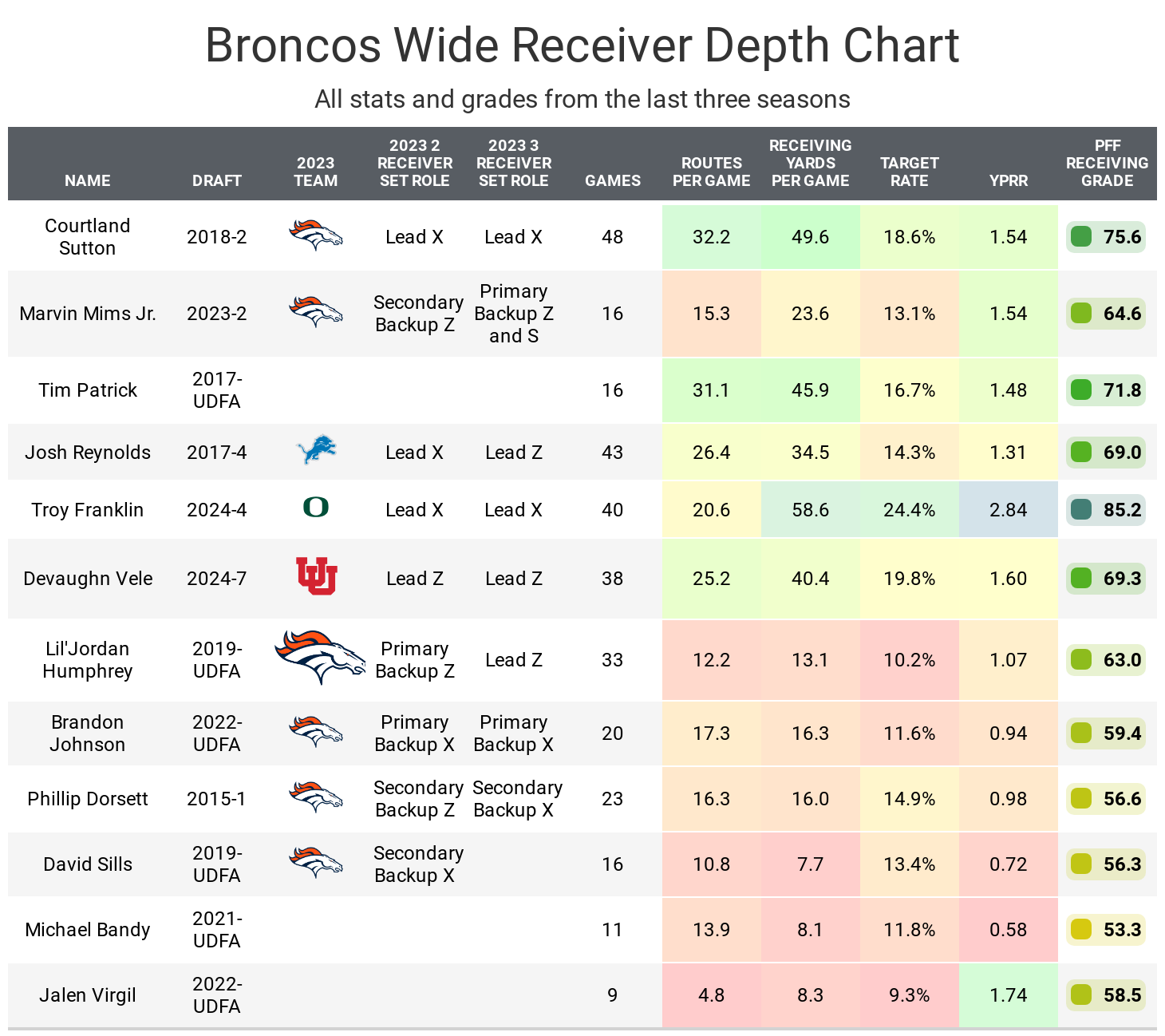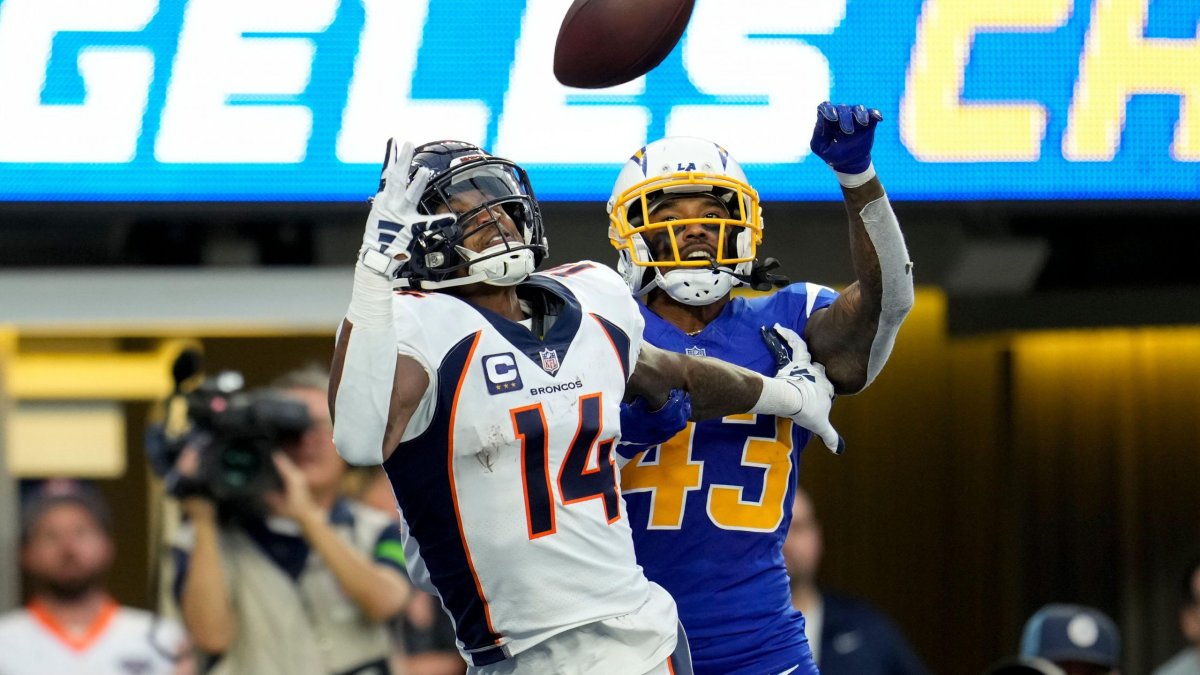• Courtland Sutton is the Denver Broncos‘ clear top receiver: At least five Broncos wide receivers have a realistic shot at being second on the depth chart, with no one close to Sutton.
• Everything else limits his upside: At this point, Sutton has shown he’s not an elite receiver and is playing alongside a questionable quarterback situation with a head coach who has recently focused on running backs.
• Get a head start on fantasy football: Use PFF's fantasy football mock draft simulator to create real live mock draft simulations to prepare for your live draft!
Estimated reading time: 5 minutes
The PFF player profile series gives the most in-depth view of a player possible. The profiles use the best data points at PFF’s disposal to examine how well the player has performed, what competition the player has for touches and how other teammates and coaches will impact each player's performance.
Last updated: 7:15 a.m. Thursday, July 11
Player Performance
Sutton is an above-average wide receiver who is good at most things. He runs an above-average number of routes, often leading to an above-average number of yards with above-average efficiency.
He’s particularly stood out against man coverage, which teams like to see from X wide receivers, but teams that face the Broncos tend to use a lot more zone coverage.
Last season, Sutton's fantasy value was helped tremendously by his 10 touchdowns, which were tied for fourth-most among all wide receivers. However, this is likely to regress. He averaged 0.62 touchdowns per game last season, but his average over the rest of his career is just 0.22.
The league's most consistent touchdown scorers are typically also threats when their team is in scoring range. The 16 wide receivers who scored eight-plus times last season averaged a 27.3% target rate when their team was within 10 yards of the end zone, but Sutton was at 17.9%. His target share has been much higher from the 11-20-yard line, but it is harder to consistently score touchdowns from that range.
If all of the wide receivers in the league were on generic rosters with generic quarterbacks, depth charts and coaching, Sutton would be around WR40-45.
This is worth noting because Sutton wants a new contract. He showed up to minicamp but reportedly hasn’t ruled out a training camp holdout. He was the subject of trade rumors last season, too, and those rumors probably won’t go away until Sutton gets a new contract or the trade deadline has passed.


Competition for Touches
Sutton fits the profile of a high-end WR2, but he is the clear top wide receiver on the Broncos' depth chart. He’s served as the X receiver in each of the last three years with multiple coaching staffs. His primary competition had been Jerry Jeudy, who was traded to the Cleveland Browns this offseason.
That lack of competition for targets has meant he's been used far more than expected.
The Broncos rostered three other wide receivers who played between 340 and 430 snaps last year, all of whom graded out in the low 60s. Lil’Jordan Humphrey and Brandon Johnson are still on the roster but will ideally fall further down the depth chart in 2024, while Marvin Mims Jr. is expected to take a step up after being drafted in the second round.
At his peak, Tim Patrick would be the clear second wide receiver on this team. However, he tore his ACL during training camp in 2022 and then his Achilles during training camp in 2023, causing him to miss both seasons. The injuries make it unlikely that Patrick will be the same player he was before the injury.
During free agency, Denver added Josh Reynolds, who has gained between 300 and 650 receiving yards in each of the last six seasons. The team also picked up Troy Franklin and Devaughn Vele in the draft, with Franklin being noteworthy not only because he played with quarterback Bo Nix in college but because he was also WR6 on PFF's big board.
This team's depth chart will be reordered several times between now and the start of the season, with any combination of receivers possible. Still, Sutton’s lack of true competition for targets is one of the biggest reasons to consider the veteran receiver in fantasy football.


Impact of Teammates
The pros of Sutton being the Broncos' top wide receiver are balanced out by the coaching and quarterback situation.
Sean Payton has been a run-heavy coach who often focuses on the running backs in the passing game more than most. In recent years, his teams have run a low number of plays per game, and given the quarterback situation in Denver right now, that should remain true for the 2024 season.
The Broncos are probably the only team with three quarterbacks who have a realistic shot at winning the starting job. While Bo Nix gives Sutton the most upside, all three are below average at targeting wide receivers. Nix graded well in college but ranked only 35th on our big board. Our draft guide notes he will “take some time to really read progressions better in the NFL.” If it takes some time for Nix to be an NFL-caliber quarterback, he might not become one until Sutton is off the roster.


Bottom Line
Sutton can often finish among the top 36 fantasy wide receivers but rarely has great games. His talent, coaching and quarterback put a limit on his upside, but his target share in Denver will keep him as a borderline fantasy starter.
He should be drafted by a team that has taken some risks at wide receiver and needs a wide receiver for when the risks aren’t working out.

Footnotes
-
- The statistics for the tables and charts were generally chosen based on their ability to predict future fantasy performance (on either a per-game or per-occasion basis) or on their ability to describe the player relative to others at the same position.
-
- Opportunities for this purpose are defined by passing dropbacks, rushing attempts and routes run as a receiver.
-
- Numbers are either by season or based on the last three years. For rookies, only college numbers are included. Only NFL numbers are included for non-rookies, even if they played in college in the last three years.
-
- Because college competition is relatively easier than NFL competition, it can be expected that most rookies see a decline in their numbers compared to their previous numbers.
-
- The colors for all of the tables in this article range from blue (good or high) to red (bad or low).
-
- All percentiles or colors compare the given player to other players with a high sample of opportunities. Generally, it’s one-third of the possible opportunities given the sample. If the player in question doesn’t have enough opportunities, they are still compared, even though a player could look really good or bad on that small sample size, which might not be as predictive.
-
- Information on running back utilization classifications and importance can be found here, wide receiver here and tight end here.




 © 2024 PFF - all rights reserved.
© 2024 PFF - all rights reserved.